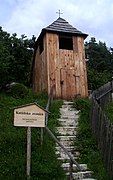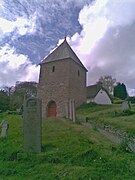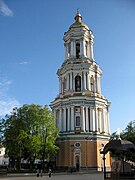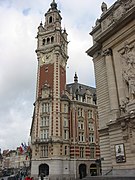Bell tower
- Campanile redirects here, for other uses see Campanile (disambiguation)

A bell tower (also belfry) is a tower which contains one or more bells, or which is designed to hold bells, even if it has none. In the European tradition, such a tower most commonly serves as part of a church and contains church bells. Modern bell towers often contain carillons.
The term Campanile (Italian pronunciation: [kampaˈniːle], English: /ˌkæmpəˈniːliː/) is synonymous with 'bell tower'; in American English it tends to be used to refer to free standing bell towers; the term is Italian, deriving from the word 'campana' meaning bell.
When attached to a city hall or other civic building, especially in continental Europe, it is often named "belfry". Elsewhere, the term "belfry" refers strictly to the part of the tower which contains the bells. Thus some bell towers have no belfry.
Old bell towers may be kept for their historic or iconic value, though in countries with a strong campanological tradition they often continue to serve their original purposes as well.
Bell towers are common in China and countries of the related cultures, where they may appear both as part of a temple complex and as an independent civic building. The tallest free-standing bell tower in the world is the Joseph Chamberlain Memorial Clock Tower, located at the University of Birmingham, UK; it is approximately 110m tall.[1][2]
Purpose
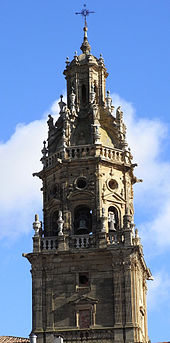
The bell is rung to signify the time, to call people to worship, for special events such as weddings and funerals, or historically to sound a civil defense or fire alarm.
Bell towers may also contain carillons or chimes, musical instruments traditionally composed of large bells which are sounded by cables, chains, or cords connected to a keyboard. These can be found in many churches in Europe and America and at some college and university campuses.[3] In modern constructions that do not qualify as carillons, rather than using heavy bells the sound may be produced by the striking of small metal rods whose vibrations are amplified electronically and sounded through loudspeakers. Simulated carillon systems have also used recordings or samplings of bells onto vinyl record, tape, compact disc, or memory chips.[4]
Some churches have an exconjuratory in the bell tower, a space where ceremonies were conducted to ward off weather related calamities, like storms and excessive rain. The main bell tower of the Cathedral of Murcia has four.
Etymology: belfry
The word belfry comes from Old French berfrei which is derived from Germanic *bergan "to protect" and *frithuz "peace"; that is, it was originally a watch tower providing protection against hostile incursions. In larger towns, watchmen in these towers were also on the lookout for fires. Though flags were used by the watchmen for communication, these towers usually contained an alarm bell or bells built into a Bell-Cot, thus Middle English speakers thought berfrei had something to do with bells: they altered it to belfry, an interesting example of the process of folk etymology.[5] Today's Dutch belfort seems to combine the term "bell" with the term "stronghold", while the Dutch term klokkenstoel (bell-chair) refers only to the construction of the hanging system, or the way the bell or bells are installed within the tower.
Distribution
Historic belfries exist throughout Europe. The Irish round towers are thought to have functioned in part as bell towers. Famous medieval European examples include Bruges (Belfry of Bruges), Ypres (Cloth Hall, Ypres), Ghent (Belfry of Ghent). In 1999 thirty-two Belgian belfries were added to the UNESCO's list of World Heritage Sites. In 2005 this list was extended with one Belgian and twenty-three French belfries and is since known as Belfries of Belgium and France. Most of these were attached to civil buildings, mainly city halls, as symbols of the greater power the cities in the region got in the Middle Ages; a small number of buildings not connected with a belfry, such as bell towers of—or with their—churches, occur also on this same list (details). In the Middle Ages, cities sometimes kept their important documents in belfries. Not all are on a large scale; the "bell" tower of Katúň, in Slovakia, is typical of the many more modest structures which were once common in country areas. Archaic wooden bell towers survive adjoining churches in Lithuania and as well as in some parts of Poland.
In orthodox eastern Europe bell ringing also had a strong cultural significance (Russian Orthodox bell ringing), and churches were constructed with bell towers (see also List of tall Orthodox Bell towers).
Bell towers (Chinese: Zhonglou, Japanese: Shōrō) are common in China and the countries of the related cultures. They may appear both as part of a temple complex and as an independent civic building, often paired with a drum tower, as well as in local church buildings. Among the best known examples are the Bell Tower (Zhonglou) of Beijing and the Bell Tower of Xi'an.
In the modern period bell towers have been built throughout the western world as follies, memorials and as decorative-iconic monuments - being common on University campuses, and other civic institutions.
-
Old Belfry of Todaiji, Japan (752, rebuilt 1200)
-
Separate Bell-tower at Feock Church, Cornwall (13th Century)
-
Inside the belfry of St Medard & St Gildard's, England (13th C.)
-
Beijing Bell Tower (1272, reconstructed 1420, 1800)
-
Bell Tower of Xi'an (1384)
-
Belfry of Aalst, Belgium (1460)
-
Ivan The Great Bell Tower, Moscow, Russia (1508)
-
Great Lavra Belltower of Kiev Pechersk Lavra, Ukraine (1745)
-
Belfry of Bruges, Belgium (1240) (modified 1480s, 1820)
-
Belfry of Lille, France (1921)
-
The Campanile at the University of Kansas, Lawrence, KS (1950)
-
The bell tower at University of California, Riverside (1960s)
-
'Swan Bells', Perth, Western Australia (2000)
See also
References
- ^ "25 tallest clock towers/government structures/palaces" (PDF). Council on Tall Buildings and Urban Habitat. January 2008. Retrieved 2008-08-09.
- ^ "Campus tour booklet" (PDF). University of Birmingham. Retrieved 2008-08-09.
- ^ "The World Carillon Federation (WCF)". Carillon.org. Retrieved 2012-02-19.
- ^ "Millennium Digital Electronic Bell Carillons by Chime Master". Chimemaster.com. 2012-02-03. Retrieved 2012-02-19.
- ^ Kingsley Amis (2011). The King's English. Penguin Group. p. 145. ISBN 978-0-14-119431-8.



